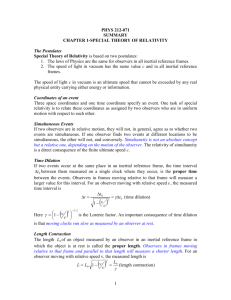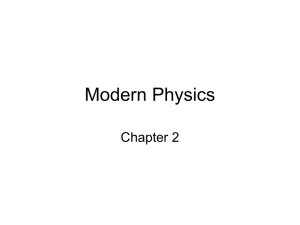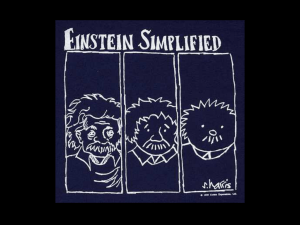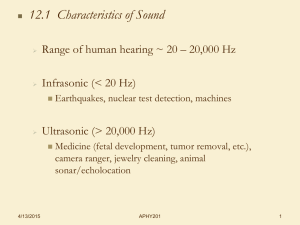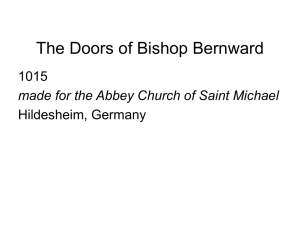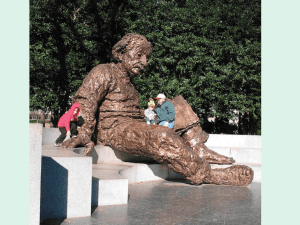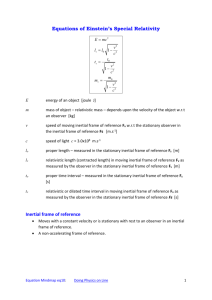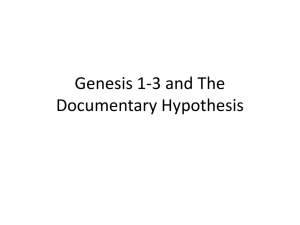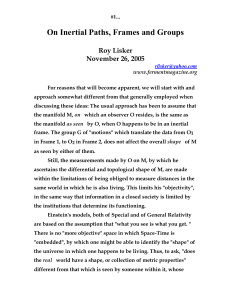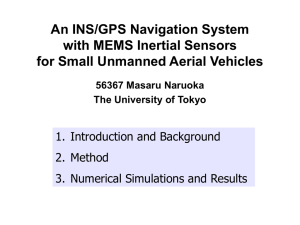Ch. 13 Lecture
advertisement
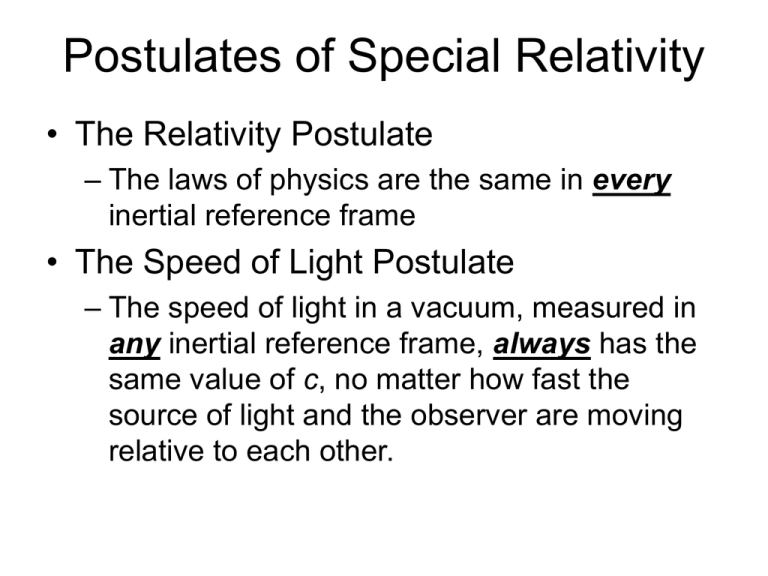
Postulates of Special Relativity • The Relativity Postulate – The laws of physics are the same in every inertial reference frame • The Speed of Light Postulate – The speed of light in a vacuum, measured in any inertial reference frame, always has the same value of c, no matter how fast the source of light and the observer are moving relative to each other. The Relativity Postulate • The laws of physics are the same in every inertial reference frame – Inertia • the tendency for an object at rest to remain at rest or an object in motion to remain in motion • Newton’s 1st Law (Law of Inertia) – A body will remain at rest or move in a straight line at a constant speed unless acted on by a net outside force • An inertial reference frame is a frame at rest or in motion at a constant speed – Not an accelerating reference frame • Not rotating • Not free-falling The Relativity Postulate • The laws of physics are the same in every inertial reference frame – There is no preferred reference frame – Any inertial reference frame is as good as any other – This has interesting consequences since, according to relativity, time is a relative quantity, too • no absolute time – only a direction to time’s arrow • no absolute velocity – only relative velocities • this is a departure from Newton’s Laws where time and space are absolute Speed of Light Postulate • The speed of light in a vacuum, measured in any inertial reference frame, always has the same value of c, no matter how fast the source of light and the observer are moving relative to each other. Inertial frame Inertial frame Both observers measure the light to be traveling at v=c=299,792,458 m/s!!!! Speed of Light Postulate • The speed of light in a vacuum, measured in any inertial reference frame, always has the same value of c, no matter how fast the source of light and the observer are moving relative to each other. – This fact was actually experimentally confirmed before the theory of relativity was developed • Series of experiments by A.A. Michelson & E.W. Morley over the period 1883-1887 showed speed of light did not depend on the motion of the inertial frame • The wavelength (& frequency) of light do depend on the motion of the source & observer – Doppler shifting Time Dilation • Build a “light clock” Time Dilation • Measure “proper” time interval – time interval in the frame of the clock proper time interval 2D t0 c Time Dilation • Now measure time interval from another inertial frame from which the clock appears to be in motion dilated time interval 2s 2 D 2 L2 t c c If L 0, t t0 Time Dilation t t0 v2 1 2 c • Δt0 = proper time interval between 2 events as measured by an observer who is at rest with respect to the events and sees them occurring at the same place • Δt = dilated time interval measured by an observer who is in motion with respect to the events and sees them occurring at different places • v = relative speed between the two observers • c = speed of light in a vacuum This effect has been experimentally verified using very accurate atomic clocks Time Dilation • All clocks are affected by time dilation – light clocks, quartz-crystal clocks, mechanical clocks, biological clocks Twin Paradox A pair of twins, Adam and Eve, are thinking of what will happen to their ages if one of them goes away from Earth on a space journey. Will Eve for example be younger, older, or have the same age as her brother if she leaves Earth with a space-ship and then returns after some time? Consider what happens to Eve from two perspectives: • To Adam, Eve appears to age more slowly due to time dilation Adopted from Nobelprize.org website • Eve doesn’t notice anything unusual – all clocks in her frame appear to her to run normal Twin Paradox A pair of twins, Adam and Eve, are thinking of what will happen to their ages if one of them goes away from Earth on a space journey. Will Eve for example be younger, older, or have the same age as her brother if she leaves Earth with a space-ship and then returns after some time? Consider what happens to Adam from two perspectives: • Adam doesn’t notice • To Eve, Adam anything unusual appears to age more slowly due – all clocks in his frame appear to to time dilation him to run normal Adopted from Nobelprize.org website Twin Paradox • How do we resolve the paradox? – Remember, in special relativity, observers must be in inertial (non-accelerating) frames – For Eve to turn her rocket around and return to Earth, she must accelerate. • Therefore she is not in an inertial frame the entire time. – Adam remains in an inertial frame the entire time, so his observations are the correct ones • Eve will, in fact, age more slowly than her twin and be younger than Adam upon her return to Earth – A full treatment of relativity shows that there is no real paradox. Eve will, in fact, see Adam age more quickly than herself over the course of the trip. Time Dilation & Forward Time Travel • Traveling at close to the speed of light allows one to age more slowly relative to people in another reference frame • In a sense, this allows one to travel forward in time Restrictions on Traveling at the Speed of Light E mc 2 m • Energy and mass are equivalent m0 2 v 1 2 c E m0c 2 2 v 1 2 c – mass can be converted to energy – energy can be converted to mass • Inertial mass of an object increases without bound as vc • Require more and more energy to keep accelerating an object toward c – Requires infinite energy to reach c Wormholes Science Fiction: Science: • Wormholes • Einstein-Rosen bridge – Time travel – Tunnels to alternate universes – Unstable structures – May be impossible to traverse Wormholes Length Contraction L0 vt v t0 L vt0 2 v 1 2 c v2 L L0 1 2 c
